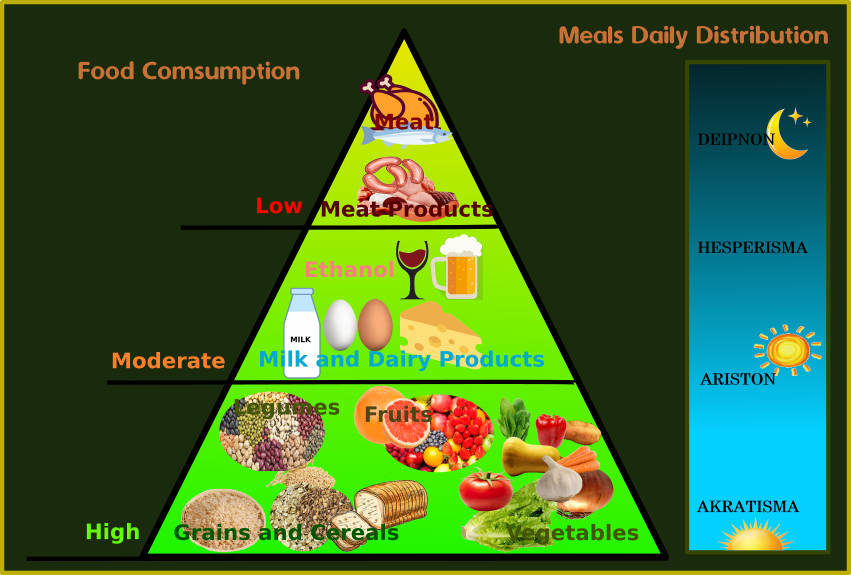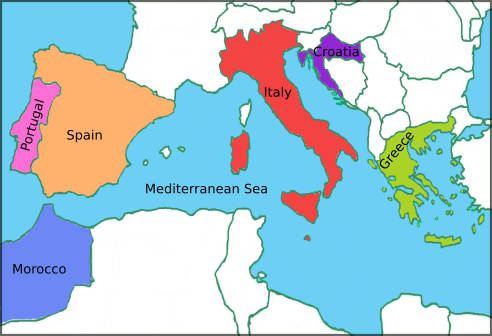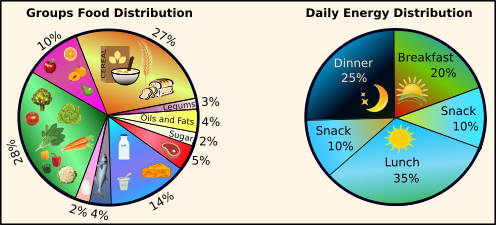NutriScience for everybody
Mediterranean diet pattern
The traditional Mediterranean diet, and in particular the Greek version of it, may be thought of as having eight components:1. high monounsaturatedsaturated fat ratio; 2. moderate ethanol consumption; 3. high consumption of legumes; 4. high consumption of grains and cereals; including bread; 5. high consumption of fruits; 6. high consumption of vegetables; 7. low consumption of meat and meat products, and 8. moderate consumption of milk and dairy products[3]. Bioactive compounds include a range of non-nutritive substances thought to confer health benefits, including polyphenolic compounds and phytosterols. The most notable of the polyphenols are flavonoids, water soluble plant components which are known to have antioxidant properties in vitro [8].

According to Athenaeus of Naucratis, the word dais signified a meal, and was derived from the verb, daiesthai, “to divide” or “to distribute equally,” and he wrote that men who roasted meat were called diatros, or “dividers,” because they provided equal portions of meat. Athenaeus cited Philemon of Syracuse, who wrote that the Greeks ate four meals daily: akratisma, ariston, hesperisma, and deipnon. Three components characterized the Greek evening meal: sitos, opson, and oinos. Staple foods, collectively called sitos, were served first and included barley, lentils, and wheat. Complementing the sitos were relishes, or opson, such as cakes, cheese, eels, eggs, fish and shellfish, lettuce, mullet, oysters, shrimps, broiled tunny (tuna), and perhaps thrushes. Different meat courses commonly followed, maybe goat, mutton, and pork, sometimes sausage and lesser cuts such as feet and pig’s snout, kid’s head, and sometimes domesticated fowl. During the third component, oinos, which concluded dinner, wines were served with tragemata, or collectively, sweet cakes, various confections, curdled cream, dried and fresh fruits, honey, and nuts[9].
The Mediterranean diet was first defined by Ancel Keys as being low in saturated fat and high in vegetable oils, observed in Greece and Southern Italy during the 1960s[10]. Since the early 90s, the healthy Mediterranean diet pattern has been popularized using a pyramid representation as a dietary guideline, were the foods for daily, weekly or less frequent consumption, were highlighted graphically[1]. Diet pyramids are considered a useful way to display the general principles of a diet including approximate recommendations for quantities of food groups. The Mediterranean diet pattern includes guidelines for high intake of extra virgin (cold pressed) olive oil, vegetables including leafy green vegetables, fruits, cereals, nuts and pulses/legumes, moderate intakes of fish and other meat, dairy products and red wine, and low intakes of eggs and sweets and each description provides an indication of the frequency these foods should be consumed [10].
_______[1] Dernini , Sandro and , Elliot M. 2015. Mediterranean diet: from a healthy diet to a sustainable dietary pattern.Frontiers in nutrition. Volume 2, Article 15.
[2] Hoffman, Richard and Gerber, Mariette. 2012. The Mediterranean Diet. Health and Science. Wiley-Blackweell.
[3] Trichopoulou , Antonia and Lagiou, Pagona. 1997. Healthy Traditional Mediterranean Diet: An Expression of Culture, History, and Lifestyle. Nutrition Reviews, Vol. 55, No. 11.
[4] Berry, Elliot M et al. 2011. The Middle Eastern and biblical origins of the Mediterranean diet. Public Health Nutrition: 14(12A), 2288–2295.
[5] Altomare, Roberta et al. 2013. The Mediterranean Diet: A History of Health. Iranian J Publ Health, Vol. 42, No.5, pp.449-457.
[6] Lacirignola, Cosimo wt al. 2015. Mediterranean food consumption patterns Diet, environment, society, economy and health. FAO.
[7] Preedy, Victor R. and Watson, Ronald Ross. 2015. The Mediterranean Diet. An Evidence-Based Approach. Elsevier.
[8] Davis, Courtney et al. 2015. Definition of the Mediterranean Diet: A Literature Review. Nutrients 2015, 7, 9139–9153.
[9] Matalas, Antonia-Leda et al. 2001. The Mediterranean Diet: Constituents Health Promotion and Health Promotion. CRC Press.
[10] Davis, Courtney et al. 2015. Definition of the Mediterranean Diet: A Literature Review. Nutrients, 7, 9139–9153; doi:10.3390/nu7115459
Mediterranean diet overview

The Mediterranean diet is an expression of the different food cultures present in the Mediterranean region, with diverse food consumption and production patterns, in continuous evolution, representing the particular historical and environmental mosaic that is the Mediterranean[1]. The Mediterranean diet has been well characterized scientifically. It is also recognized as healthy dietary pattern and now it is being analyzed in many surveys and it is appreciated for its lower environmental impact [6]. The “Mediterranean diet”, recognized by UNESCO as an intangible heritage of humanity in 2010, could be considered as a model of sustainable diets in the Mediterranean basin, and able to contribute to the sustainability of the agro-food systems around the Mediterranean and to the valorization of quality products[6].
The origins of the “Mediterranean Diet” are lost in time because they sink into the eating habits of the Middle Ages, in which the ancient Roman tradition —on the model of the Greek— identified in bread, wine and oil products a symbol of rural culture and agricultural (and symbols elected of the new faith), supplemented by sheep cheese, vegetables (leeks, mallow, lettuce, chicory, mushrooms), little meat and a strong preference for fish and seafood (of which ancient Rome was very gluttonous)[5]. The Mediterranean basin has been, for millennia, a cross-roads of people and civilizations. Here, for 5000 years, boats, carriages, people, and merchandise, as well as creative ideas and religions, have converged[3]. Although different regions in the Mediterranean basin have their own diets, it is appropriate to consider these as variants of a single entity, the Mediterranean diet[3].
The term Mediterranean diet was coined in 1960 by the American physiologist Ancel Keys and his wife Margaret. They identified the eating behaviors of countries such as Greece —Crete in particular— and southern Italy, with extension to other geographical areas around the Mediterranean basin. Based on their pioneering studies, the dietary patterns of these countries were associated with longevity and reduced rates of coronary heart disease morbidity and mortality, cancers, and other chronic diseases related to diet in the 1960s[2].
The Mediterranean diet based on the diet of Crete (before 1960) has been significantly correlated with extended life expectancy and the lowest global incidence of Coronary Heart Disease, as well as certain cancers and other chronic diseases. In the USA, there were three times more deaths due to cancer and Coronary Heart Disease than in Crete and this differential has only increased recently[4].
___________
[1] Dernini , Sandro and , Elliot M. 2015. Mediterranean diet: from a healthy diet to a sustainable dietary pattern.Frontiers in nutrition. Volume 2, Article 15.
[2] Hoffman, Richard and Gerber, Mariette. 2012. The Mediterranean Diet. Health and Science. Wiley-Blackweell.
[3] Trichopoulou , Antonia and Lagiou, Pagona. 1997. Healthy Traditional Mediterranean Diet: An Expression of Culture, History, and Lifestyle. Nutrition Reviews, Vol. 55, No. 11.
[4] Berry, Elliot M et al. 2011. The Middle Eastern and biblical origins of the Mediterranean diet. Public Health Nutrition: 14(12A), 2288–2295.
[5] Altomare, Roberta et al. 2013. The Mediterranean Diet: A History of Health. Iranian J Publ Health, Vol. 42, No.5, pp.449-457.
[6] Lacirignola, Cosimo wt al. 2015. Mediterranean food consumption patterns Diet, environment, society, economy and health. FAO.
[7] Preedy, Victor R. and Watson, Ronald Ross. 2015. The Mediterranean Diet. An Evidence-Based Approach. Elsevier.
Mediterranean diet dietary recommendations
The Mediterranean Diet Foundation (2011) is recommending the intake of foods servings and meals frequency as it is indicated in The food guide Mediterranean diet.

As an expression of culture, history and lifestyle, several elements characterize the Mediterranean diet such as: 1. the daily food intake is distributed as four or five meals according to season and in proportion to labour intensity, the first and second daily meals (breakfast and lunch) were more important than the evening meal (dinner); 2. meal is shared in a calm and peaceful environment; 3. a large diversity of foods are consumed in small quantities, contributing a variety of textures and tastes; 4. foods are minimally processed, and they are seasonal and locally produced; 5. people use simple cooking methods, and (6) there is a marked distinction between common days and festivities[1]

Portions of main meals and recommended
daily and weekly
frequency of consumption[2]
Aliments |
WQ |
Portion |
Examples |
Tips |
| Fruits | 3 WQ/day |
150 g |
Big products (apple, oranges, etc.) 1 big fruit. Little fruits (prunes, tangerines, etc.) 2-3 pieces. | Variety in the choice of the colors: red, white, green, orange; each one has specific properties. |
| Vegetables | 3 WQ/day |
250 g green 50 g salad |
A middle-big vegetable. | |
| Bread | 2-3 WQ/day |
50 g |
A medium sandwich or a little slice. | Limit the intake of flavored bread (milk, oil, nuts, olives, etc.) and fresh egg pasta and ravioli. Remember to reduce the amount for soups. |
| Pasta/Rice | 1 WQ/day |
80 g rice and dried pasta 120 g egg pasta |
||
| Biscuits | 1 WQ/day |
20 g |
2-4 biscuits | |
| Potatoes | 2 WQ/day |
200 g |
2 medium potatoes | |
| Meat | 5 WQ/week |
100 g |
1 slice or 2 meat balls | Prefer lean meats, fish and pulse (whole quality improve if consummed with bread). |
| Fish | 2 WQ/week |
150 g |
A medium slice | |
| Eggs | 2 WQ/week |
60 g |
An egg | |
| Cold cuts | 3 WQ/week |
50 g |
3 slice of ham or 3-7 slice of salami | |
| Pulse | 2 WQ/week |
30 g dried 50 g fresh |
||
| Milk & yogurt | 14 WQ/week |
125 ml |
A glass of milk or a jar of yogurt | Prefer low-fat milk and not too fat products, the low-fat fruit yogurt. Prefer vegetable fats.
|
| Cheese | 4 WQ/week |
50 g ripe 100 g fresh |
A medium portion | |
| Butter | 5 WQ/week |
50 g |
5 tablespoons | |
| Oil | 2-3 WQ/day |
10 g |
1 tablespoons | |
| Sugar & honey | 3 WQ/day |
5 g |
A teaspoon | It is recommended replace sugar with honey that has double sweetness |
______
[1] Martins Delgado, Amelia et al. 2017. Chemistry of the Mediterranean Diet. Springer.
[2] Altomare, Roberta et al. 2013. The Mediterranean Diet: A History of Health. Iranian J Publ Health, Vol. 42, No.5, pp.449-457.
Mediterranean diet, it is a good diet?

Mediterranean diet is not at all a good diet. Unfortunately Mediterranean diet does not care at all about the quality of food. For example Italian people eat a lot of pasta made with white flour, in Spain people consume a lot of fried tomatoes. Foods made with white flour, fried foods and sausages included in the Mediterranean diet are poisoning foods.
The good things of Mediterranean diet is that this diet are including a lot of vegetables and fruits.
eidos-project.net © 2016- 2024